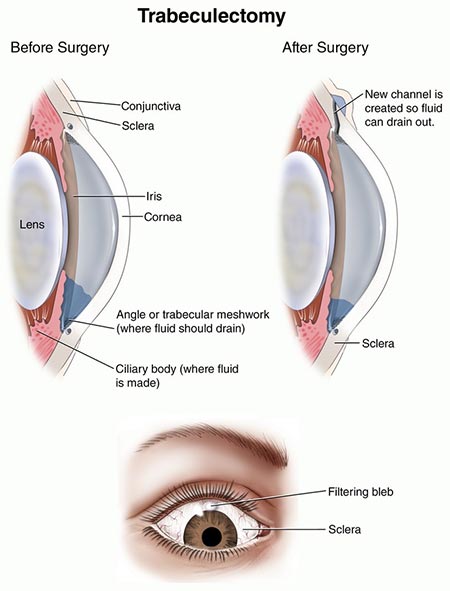The newest type of glaucoma surgery is called MIGS or Micro-Invasive Glaucoma Surgery. This type of surgery has been quickly evolving and gaining popularity for about the past 10 years. I like to think of this surgery as similar to what we call endoscopic surgery. An example would be that of having your appendix or gall bladder removed with three small scopes instead of a large incision across your abdomen. Comparatively, MIGS allows for microscopic surgical glaucoma intervention versus the larger incision trabeculectomy or tube glaucoma surgery.
Currently, there are several types of MIGS surgery. They include cyclophocoagulation, trabeculotomy, and drainage management, all to help lower eye pressure. While these surgeries have proven successful, they only provide a moderate amount of pressure relief. There will always be a need for more traditional glaucoma surgery where a large amount of pressure control is needed.
Some of the MIGS procedures are only approved to be done in conjunction with cataract surgery such as the Istent and the Hydrus. Both of these procedures involve implanting a microscopic stent (like a stent you might get with a heart surgery) into the ‘drain’ portion of the eye at the same time as cataract surgery is completed. This stent allows the fluid inside the eye to drain better and thus lowers the pressure. Trabeculotomy accomplishes drainage improvement by opening up the natural drain of the eye and not using stent. Cyclophotocoagulation uses a laser applied to the portion of the eye that produces fluid, thus effectively turning down the faucet, if you will, instead of opening up the drain, to lower the eye pressure.
Another type of MIGS developing quickly is using a micro stent to drain fluid from inside to outside of the eye, similar to more invasive surgeries like trabeculectomy or tube surgery, just on a smaller scale. This is called the XEN micro gel stent. It can be done in conjunction with cataract surgery or by itself. A small stent is placed precisely from inside the eye to the outside just near the natural drain of the eye. This creates a bleb similar to a trabeculectomy lowering the eye pressure. It lowers pressure a moderate amount and takes a fraction of the time to complete compared to the older style of surgery. It still requires close postoperative observation and management and may require an enhancement if it starts to fail.
The nice thing about MIGS glaucoma treatments is that there are multiple options all with good pressure lowering capabilities and less side effects or risks than traditional surgery. However, if a MIGS procedure does not work, a more traditional surgery such as trabeculectomy is always an option.
Speak to your doctor about the MIGS options and whether you may be a candidate for these new and exciting procedures.












